Weight training is very important to all sports, including wakeboarding. There are many physical demands placed on the body while wakeboarding and a conditioning program will help keep injuries to a minimum.
I recommend a standard 3 day per week weight training program with one day rest between each workout. Split your workout into body parts because it is best to let the muscles recover for 5-7 days after training them. Monday train your legs, Wednesday train your chest, shoulders and triceps, and Friday train your back, biceps, and traps. In your weight training you should focus attention towards wakeboarding. For example, think of how you hold the rope while boarding and use that form on your cable rows (palms down and grip about 12 inches apart - use this position instead of an underhand or "V" grip). Train with weights for 30-60 minutes per workout.
Always do a five minute shot on the cardio equipment for a warm-up (yea, even you 16-18 year olds!) and remember to stretch before your workout.
Here is an example of a weight training routine which is well rounded and effective. Click on the images to see larger versions.
Legs
Squats
- 2 light warm-up sets
- 2-3 full sets of 10-12 repetitions
(Note: Leg press may be substituted for squats, but squats are more demanding and therefore more effective.)
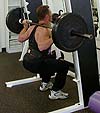
Leg extensions:
- 2-3 sets of 10-12 repetitions
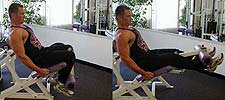
Leg curls:
- 3 sets of 10-12 repetitions
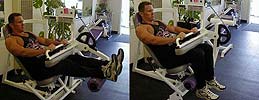
Calf raises:
- 1 warm-up set, 3 sets of 10
(Note: keep the repetitions slow and the knees straight)
Lunges:
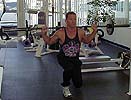
Chest, Shoulders, and Triceps
Flat Bench press:
- 2 light warm-up sets
- 3 sets of 10-12 repetitions
Incline Dumbbell Press:
Fly:

Dumbbell Overhead Press:
- 1 warm-up set of 12
- 2-3 sets of 10-12
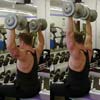
Lateral Raises:
Upright Rows - wide grip:
Triceps Push-downs:

Hanging Leg Raises:
Rope Crunches:
Back, Biceps, & Traps
Wide Grip Pull Downs:
- 2 warm-up sets
- 3 sets of 10

Overhand Row:
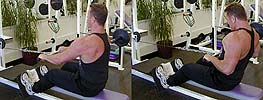
Close Grip Pull downs:
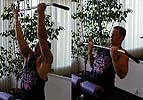
Close Grip Upright Rows:
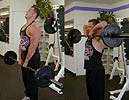
Shrugs:

Dumbbell Curls:
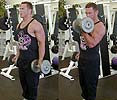
Hammer Curls:
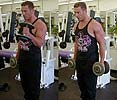
Reverse Curls:

Hyper Extensions:
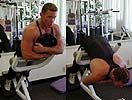
Plyometrics
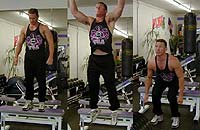 I also recommend extra attention to legs in the area of ballistic/plyometric types of movements, such as side to side jumps with the feet in different positions. Plyometric exercises stretch the muscle and, therefore, putting a load on the muscle during the stretching phase and then rapidly unloading the muscle and exploding out of the stretch (a stretching of the muscle while under force followed by an explosive contraction = Plyometrics). Plyometrics allow the muscles to reach maximum strength in as short of time as possible while providing extra strength for the tendons and muscles themselves.
I also recommend extra attention to legs in the area of ballistic/plyometric types of movements, such as side to side jumps with the feet in different positions. Plyometric exercises stretch the muscle and, therefore, putting a load on the muscle during the stretching phase and then rapidly unloading the muscle and exploding out of the stretch (a stretching of the muscle while under force followed by an explosive contraction = Plyometrics). Plyometrics allow the muscles to reach maximum strength in as short of time as possible while providing extra strength for the tendons and muscles themselves.
Example: stand on a bench, jump off, when you land and absorb the impact by bending the knees you are loading the muscle with a stretch under pressure. Then you explode back up and jump into the air. Get back up on the bench and do it again. That's a plyometric exercise.
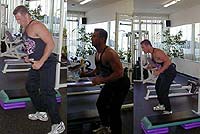 Other ballistic exercises to do include exercises replicating movements you will perform while on the water. Set up a step in the room you're training in and stand to one side of it. Place your feet like you would on your board and jump over the step and back for sets of 10. Make sure to keep your feet in the same stance. Think about strengthening your knees with this one. Plyometrics can be of great help in developing muscles used in boarding, and there are many different ways to do them. Do these types of activities 1-2 times a week for three sets of three exercises, but no more.
Other ballistic exercises to do include exercises replicating movements you will perform while on the water. Set up a step in the room you're training in and stand to one side of it. Place your feet like you would on your board and jump over the step and back for sets of 10. Make sure to keep your feet in the same stance. Think about strengthening your knees with this one. Plyometrics can be of great help in developing muscles used in boarding, and there are many different ways to do them. Do these types of activities 1-2 times a week for three sets of three exercises, but no more.
There should be lots of info on the web about plyometric exercises.
Abs
Abs are very important for all sports, especially wakeboarding. Do them hard and heavy 1-2 days per week. Include leg raises in your ab routine (try to get out of a raley without abs!). Squeeze very hard throughout the entire exercise and do three sets of crunches with your legs over a bench and your back on the floor. Follow this with hip or leg raises for three more sets.
Try balance activities such as doing some exercises on one of those Plyo-balls (the big ones). Stability and the development of supporting muscles (i.e. the small ones) will help you with your balance and being able to land more tricks at all levels of ability.
Stretch! Flexibility helps keep you loose and injury free. Stretch daily, especially your hamstrings.
Cardiovascular
Cardio is a given, but I would recommend interval training for your cardio. Rather than just running (for example) for 20 minutes, run for five minutes as a warm-up then sprint fast for a minute and back down to a jog. Continue this progression for the rest of your 20 minute cardio session pushing every "up" interval harder and harder until the last one kicks your ass! You can easily see how this will be effective in training for wakeboarding; you do a trick and rest for a few, then hit another trick, and so on.
The better condition you are in, the less chance of injury you will have. This program style will help all levels of wakeboarders. Good luck!
Brett A. Riesenhuber is the owner of Prime Physique Fitness Specialists Personal Training Center
in San Jose California. Brett holds a degree in Human Performance from San
Jose State University and is a Certified Personal Trainer.

rmotoxxx711
rmotoxxx711
cbayuk
https://vimeo.com/10520008
nautiqueboarder10
Hooya
no no no! Regardless of what you do you have to train your whole body. Not only because your body works as a unit but you will get imbalances not working you whole body.
"it puts stress on the ACL in the knee"
Any exercises put a stress on the area you are training. That is the point of training. Doing leg extensions will not be the cause of an ACL injury. Most ACLs are down to poor muscular balance around the join or impact.
"Emphasizing the whole core for wakeboarding is key"
squats, over head squats and the such like are probably the best 'core' exercises you can do.
Hooya
Not sure I personally would train abs with crunches either. Most of the work goes through the hip flexors and not sure anyone really wants tight hip flexors.